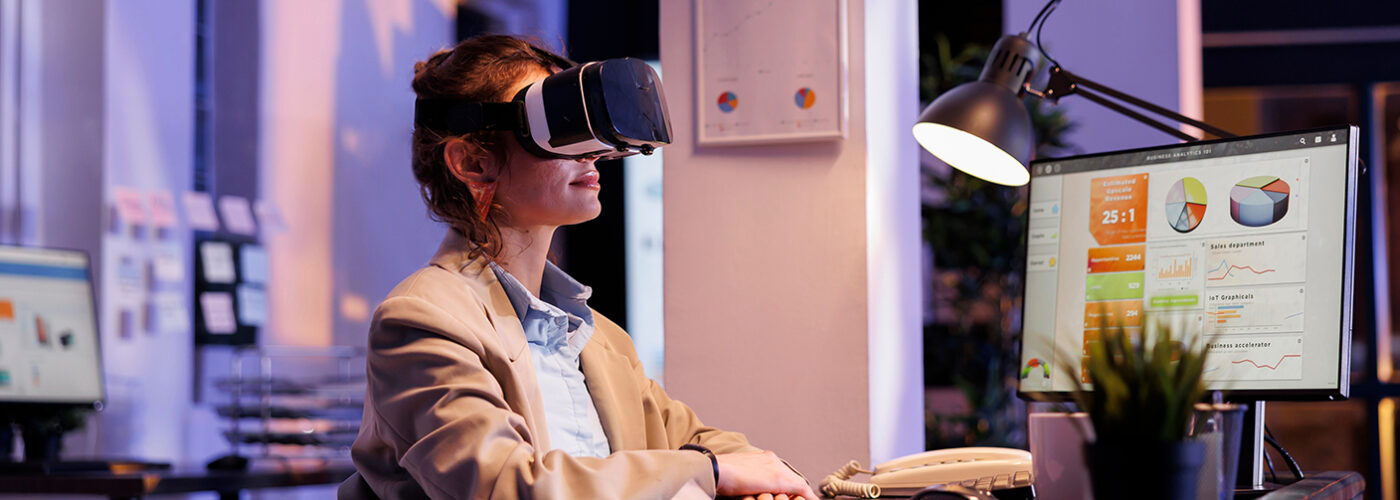
Beyond Fun and Games: The Strategic Value of Game-Based Learning
March 11, 2025
Seamless Onboarding eLearning Solutions for Modern New Hires
June 8, 2023Author

Kadamberi Darad
Virtual reality training is a simulation-based eLearning that differs from the real world, sometimes significantly. There is a huge variety of virtual reality training solutions offering the most effective knowledge retention, while building skills and confidence. It also does a tremendous job which many trainers find difficult to do - training learners how to make decisions and readying them for situations they might encounter in the real world, with up-to-date knowledge and improved confidence. Virtual reality training offers:
- A safe learning environment
- No direct exposure to hazards
- No injuries while training
- Improved collaboration
- An enhanced decision-making ability
The Application of Virtual Reality Training in Real-World Scenarios
Keeping safety in mind while training multi-generational students can be tiresome for stakeholders. With virtual reality training solution, hands-on skills can be achieved in a safe environment. Experiencing the complete immersion that shuts down the physical world and maximizes the senses will allow the mind to absorb knowledge in a virtual real-world scenario.
The following are a few scenarios that discuss VR learning content:
Virtual Reality Training for Working at Heights
Falls from heights are the second leading cause of unintentional injury. Over 37.3 million falls are severe enough to call for immediate medical attention. The World Health Organization suggests two preventive measures for workers: stringent workplace safety regulations and multicomponent safety programs. What a virtual reality height training simulation might look like: Virtual reality training provides participants with a safe learning environment where they can fully understand, identify, and assess the hazards of elevated working conditions in an immersive jobsite. This involves:
- Familiarizing them with the working conditions, equipment, and essential PPE requirements such as helmets, jackets, harnesses, and gloves.
- Being given tasks at each level of training such as climbing up a tower, working on skyscrapers, scaffold erection and dismantling, and construction.
- Asking participants to identify hazardous scenes and take steps to rectify them.
- Giving the students some examples of engineering controls, administrative steps, elimination, and the opportunity to offer their own suggestions. With a wrong selection, they are guided towards the right practice.
Virtual Reality Training for Fire Safety:
The best approach is to prevent a fire spreading and execute the necessary evacuation plan. Virtual reality training offers an opportunity for participants to learn and retain the necessary knowledge without causing any harm. What a virtual reality fire training simulation might look like: To adequately train the firefighters in a safe environment to take quick preventive measures and successfully carry out fire safety operations, their training might constitute:
- A simulated environment where participants are introduced to a safe firefighting experience, indulging with types of fire, toxic pollutants, heat stress, injuries, types of extinguishers, hazardous conditions, etc.
- A detailed practice and operation of industry-standard equipment, fire extinguisher – its, nozzle, aiming, hose holding, etc. as per PASS, under several conditions with varying difficulties.
- The sensors and trackers act in a simulated environment as the participant decides to act in unique, complex, and emerging scenarios before it is too late.
- They practice in given scenarios, face consequences and again learn the right methods.
Virtual Reality Training for Healthcare:
Students can diagnose, perform surgery, and carry out real-world treatment on computer-generated patients. This helps them gain a real insight into healthcare without depending on infrastructure, a patient, or a situation. Healthcare has been the biggest adopter of virtual reality training with a growth rate of 34.9% CAGR for year 2026. What virtual reality healthcare training might look like: The transformation starts with learning about human anatomy, patient care, and improving surgery techniques, coupled with robotic surgery, so that:
- Students or clinicians can take a tour of the human body, interact with medical instruments, and use the equipment correctly.
- They can choose their role, practice the surgery, and perform diagnostic activities for critical conditions.
- Working together they share the best practices, expert views, and specialist advice to gain real-time knowledge in a collaborative environment.
- Students continue receiving real-time evaluations to stabilize their patient’s conditions.
Virtual reality training can be key for students to develop critical and necessary empathy skills. It has also worked wonders for patients in managing chronic pain, handling trauma, and overcoming emergency room scenarios.
If you continue training the same way you’ve always trained, don’t expect to get better results. — Jim Crapko
Virtual reality training is growing, and a few sectors seem to benefit more than others. The unique nature of it gives employees real-time information, data insights, and decision-making opportunities in an investigation-based setup. Contact Ozemio for impactful learning simulations for your employees, which will teach the skills they require and enable them to make the right decisions in real-world scenarios.
Related services
Product Engineering



